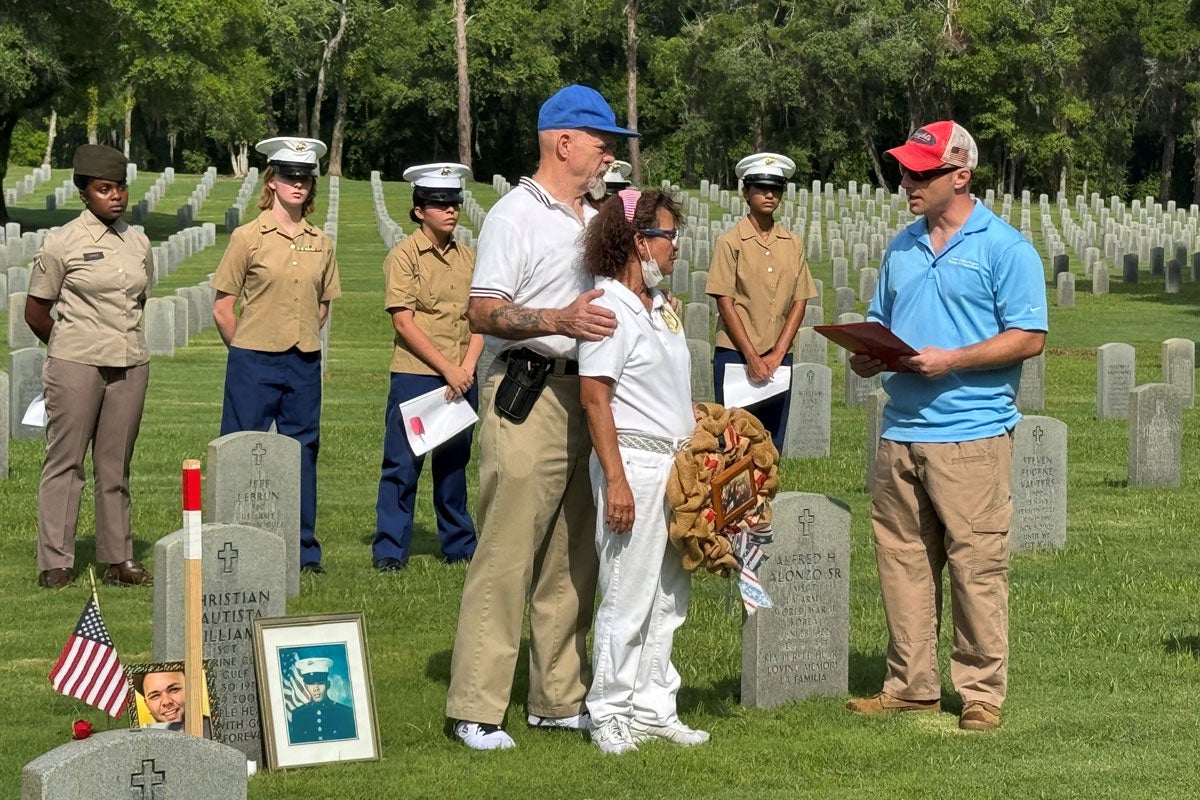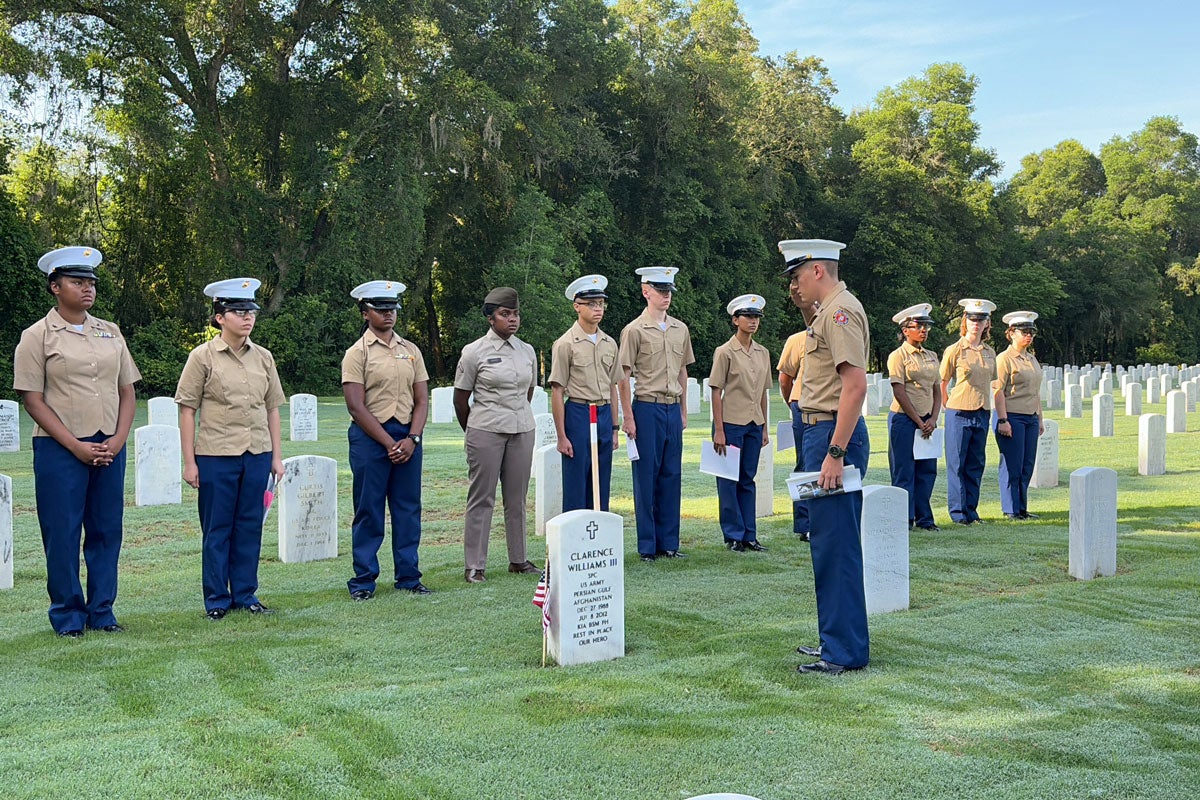A gentle breeze blows across the neat rows of headstones in the Florida National Cemetery as those gathered on this holy ground honor a chosen 12 of the more than 150,000 veterans buried there. During the event, which is a part of UCF’s Veterans Legacy Program (VLP), attendees listened to stories of veterans from the Global War on Terror, as told through the poignant research of high school students.
The program, which was founded in 2017, is a partnership with the Department of Veterans Affairs National Cemetery Administration and focuses on documenting the lives of those buried in Florida’s nine national cemeteries. Through archival research and multimedia projects, the program has captured the voices and perspectives of these remarkable individuals, shedding light on their journeys, and making them more accessible and relevant to a broader audience, including high school students.
Since 2022, the program has worked with K-12 teachers across the state to create grade-appropriate programs focused on research. UCF VLP’s website features veterans’ stories and interactive K-12 curriculum materials that any teacher may access, for all grades and subjects including history, civics, English and physical education.
Marine Corps Sgt. Maj. Ray Fullard, a JROTC instructor at Edgewater High School in Orlando, is one of the teachers participating in this program. Last year, Fullard worked closely with UCF VLP to develop a research project for 10th-12th grade students to learn about veterans who served in Iraq and Afghanistan interred at Florida National Cemetery.
Fullard’s students created reports about their assigned veterans. They prepared to present these findings at the culmination of this lesson — a field trip to the Florida National Cemetery in Bushnell, Florida. This spring, students stood before the final resting place of their veteran, sharing the story of an American who made the ultimate sacrifice for their country.
Carrying on Their Legacies
Fullard, who served throughout the Global War on Terror, concluded the event by honoring Sgt. Christian Williams. He led the team that notified the Williams family of their son’s death in Iraq in 2006 and made the preparations for Christian’s final return home. According to Fullard, Williams knew he wanted to serve in the military at a young age. His father, Jack, who retired from the U.S. Navy, spoke of when his young son would go on base and have one of the Marines sign him into the gym. The record-setting high school weightlifter began Marine Corps recruit training in the summer of 1997 and was stationed at Campe Lejeune.
Williams completed multiple tours of duty, with his third tour in early 2006 to Al Anbar Province, Iraq. Known throughout the unit as a strong and level-headed leader, Williams supported various units across services, including the 3rd Light Armored Reconnaissance (LAR) Battalion, known as the Wolfpack, emphasizing “the strength of the pack is the wolf; the strength of the wolf is the pack.”
On July 29, 2006, Williams’ platoon was stationed near Rawah when a vehicle approached their checkpoint and refused to stop. The driver was killed, but not before they detonated the improvised explosive device onboard. The explosion wracked the compound and took the lives of several in the platoon. Williams was medically evacuated but tragically succumbed to the wounds. The 3rd LAR stood down for two days after to mourn the fallen.

Williams’ immediate family, including his parents, Lisa and Jack, and his two sisters attended the event. Williams tearfully spoke to the crowd about paying the ultimate price of freedom — losing her son.
“It’s really nice to be remembered, to have my son be remembered and brought up again,” Jack Williams says. “My wife and I thought that after 20 years, it would fade into history and disappear from the rest, so we’re very pleased that somebody is carrying on an event like this because there are so many who went to war.”
As the stories come to life, the profound impact of war on not just the lives lost but those who remain becomes apparent. At the end of each presentation, the students solemnly place a coin on the veterans’ headstone and then speak their names aloud. The age-old tradition signifies those who have visited the cemetery with each coin representing a different meaning. Pennies symbolize a visit, nickels represent training together in boot camp, dimes indicate serving together and quarters signify being present when the veteran passed away. Fullard gently laid a penny on the headstone and spoke Christian Williams’ name.
“To me, today meant bringing it full circle from the time frame that my unit buried Christian Williams out here to now for my cadets to see what the cost of freedom is,” Fullard says. “All too often, we don’t know what we have until we lose it, so I want to make them understand what it costs. So, my part is making sure my young cadets understand who we are and what we do as veterans, the ones that pay the ultimate sacrifice for the freedom that we have right now.”
About the UCF Veterans Legacy Program
UCF VLP is led by UCF professors of history Amelia Lyons, Barbara Gannon and Amy Giroux from UCF’s Center for Humanities and Digital Research. It started with UCF students researching and documenting the lives of veterans by writing biographies, source packets and other interactive learning materials of veterans commemorated at the national cemeteries, six in Florida and two in eastern France. The program uses advanced technology and innovative teaching methods to allow the students to complete these biographies and honor the soldiers whose stories might be untold otherwise. The program has over 250 biographies and dozens of source packets, involving everything from government records to high school yearbooks.
To find out more about the UCF Veterans Legacy Program and to browse through the biographies and other innovative learning materials, visit vlp.cah.ucf.edu.




